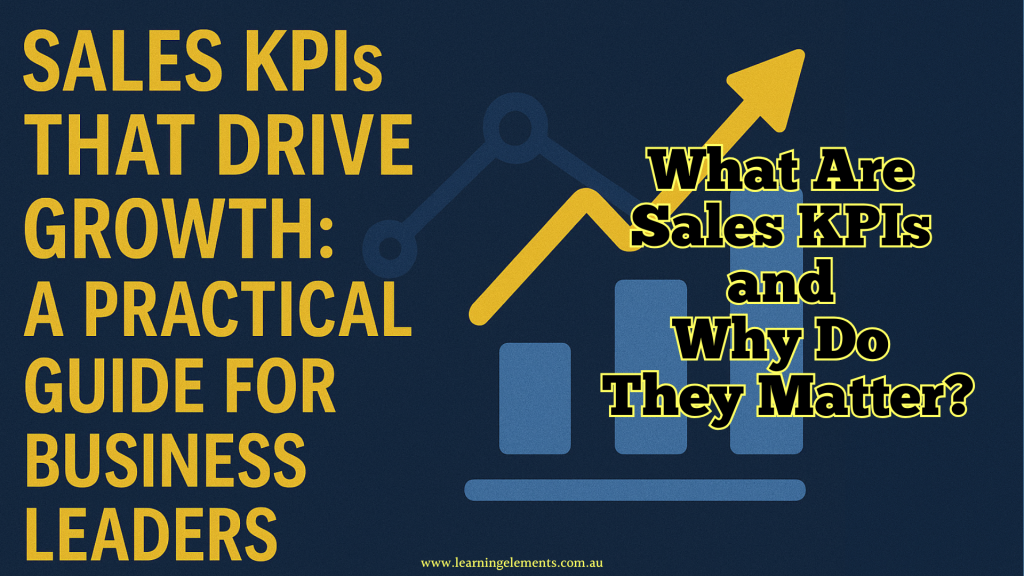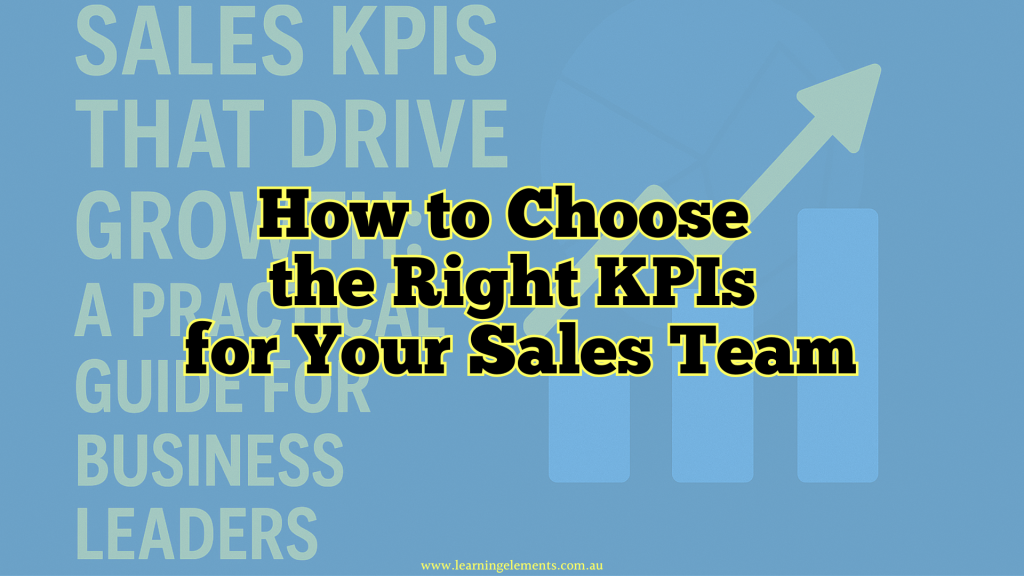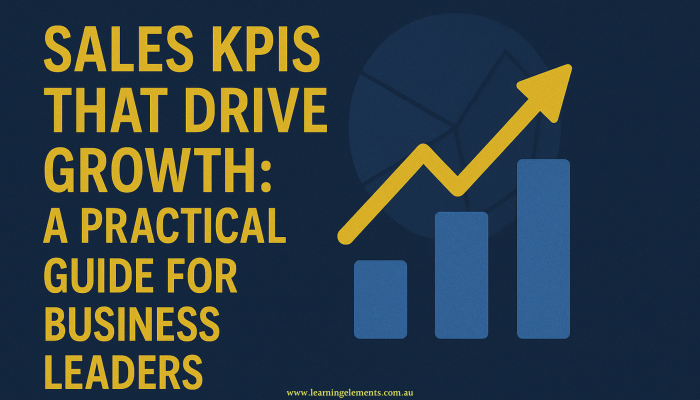Sales KPIs That Drive Growth: A Practical Guide for Business Leaders
If you’re leading a sales team today, knowing where you stand and where to focus your efforts is more important than ever. This Sales KPIs Guide is built to help business leaders make sense of performance data, select the right metrics, and use them to drive meaningful results. It’s not about tracking every number—it’s about focusing on what matters most for growth and sustainability.
Why Measuring Sales Performance Is More Important Than Ever
With increasing competition, economic shifts, and pressure to do more with less, measuring the right sales KPIs has become crucial. Without solid data, you’re guessing. With the right KPIs, you can diagnose issues, guide decisions, and improve outcomes. This sales KPIs guide gives structure to that process.

What Are Sales KPIs and Why Do They Matter?
Sales KPIs (Key Performance Indicators) are measurable values that show how effectively a sales team is achieving business objectives. They help leaders:
- Track progress against targets
- Evaluate the efficiency of strategies
- Adjust sales efforts in real time
- Identify high- and low-performing areas
When chosen and tracked properly, KPIs give leaders a clear view of what’s working and what needs to change. That’s the main aim of this sales KPIs guide—to help focus on data that drives action.
Use This Sales KPIs Guide to Focus on What Works
Before tracking any numbers, use a sales KPIs guide to assess which data aligns with your goals. Not all metrics are the same, and without a focused approach, teams can waste time reporting on irrelevant indicators. This guide is built to filter out the noise.
Need help selecting the right KPIs for your team? Contact us to talk through your goals and challenges.

The 10 Most Critical Sales KPIs to Track
1. Revenue Growth – The Ultimate Output
This is the most direct measure of success. Is your revenue increasing month over month or year over year? Sustained revenue growth shows that your sales strategies are working and that your team is effectively converting opportunities into income. It also reflects how well you’re retaining customers and expanding business with existing accounts. Monitoring this KPI helps forecast future performance and guides budgeting, hiring, and overall business planning.
2. Lead Conversion Rate – From Interest to Opportunity
This shows the percentage of leads that turn into real opportunities or customers. A low rate signals poor lead quality or ineffective selling. Monitoring this KPI helps sales leaders identify gaps in the qualification process or sales messaging. It also provides insights into how well the team is engaging prospects and moving them through the funnel. Regular analysis can guide improvements in lead sourcing, sales scripts, and follow-up tactics.
3. Sales Cycle Length – Speed = Efficiency
The time it takes from initial contact to deal close. Shorter cycles usually mean more efficiency. A long sales cycle may point to problems such as unclear messaging, weak qualification, or delays in decision-making. Tracking this KPI helps identify where deals are getting stuck and which stages need improvement. Sales teams can often reduce cycle length through better prospecting, streamlined processes, or more targeted sales enablement tools.
4. Average Deal Size – Helps Predict Future Income
Average revenue per deal helps with forecasting and understanding sales effectiveness. It gives insight into the type and value of clients your team is closing and whether you’re attracting high-value opportunities. Monitoring changes in average deal size over time can also reveal shifts in market demand or sales strategy impact. When paired with win rates, it helps sales leaders assess overall profitability and pipeline quality.
5. Win Rate – Quality of Effort
The percentage of deals won versus deals pursued. A high win rate shows strong qualification and selling. It reflects how well your team identifies viable opportunities and manages the sales process. A low win rate may point to poor targeting, weak value messaging, or gaps in sales skills. Tracking this KPI over time helps pinpoint where in the process deals are being lost and what actions are needed to improve performance.
6. Sales Activities Completed – Calls, Meetings, Demos
Track how many touchpoints your team makes. More quality activity usually drives more results. It’s not just about volume—consistency, timing, and relevance of each activity also matter. Monitoring this KPI helps managers understand effort levels, coach effectively, and spot gaps in daily execution. Over time, it reveals patterns that connect activity levels to outcomes, allowing better forecasting and resource planning.
7. Pipeline Value by Stage – Know Where Money Is Stuck
Shows where opportunities sit in the sales funnel and helps identify bottlenecks. Tracking value by stage gives you visibility into whether deals are moving as expected or getting delayed. If certain stages consistently hold most of the value, it may signal process inefficiencies, skill gaps, or misalignment in your sales approach. Analysing this KPI helps sales leaders allocate resources more effectively and intervene where progress has stalled.
8. Customer Acquisition Cost (CAC) – Efficiency Metric
How much it costs to gain a new customer. Lower CAC means better ROI. It’s calculated by dividing total sales and marketing costs by the number of new customers acquired in a given period. Tracking CAC helps you understand whether your customer growth is sustainable. When paired with metrics like Customer Lifetime Value (CLV), it gives a fuller picture of long-term profitability.
9. Quota Attainment – The Classic, but Often Misused
% of sales reps meeting targets. Used wisely, it shows team productivity—but don’t rely on this alone. Quota attainment can sometimes mask underlying issues, such as inconsistent pipeline quality or uneven target-setting. It’s also important to track how consistently reps hit quota over time—not just once. Combine this metric with others like win rate and sales activity to get a clearer view of true performance.
10. Churn Rate (for Account Management) – Are You Keeping Customers?
How many customers you lose over a set time. Retention is often cheaper than acquisition. High churn can indicate poor onboarding, weak account management, or unmet customer expectations. Regularly monitoring churn helps you act early—through support, engagement, or upselling—to keep valuable accounts. Reducing churn not only protects revenue but also strengthens long-term customer relationships.

How to Choose the Right KPIs for Your Sales Team
Choosing KPIs isn’t about tracking everything—it’s about tracking what matters. With limited time and resources, focusing on relevant indicators keeps your team aligned and productive. KPIs should drive the right actions—not just provide visibility. They help you stay focused, improve accountability, and make better decisions.
1. Don’t Measure Everything: Measure What Matters, Measure What Drives the Right Behaviours
Pick KPIs that reinforce the behaviours you want—quality calls, fast follow-ups, accurate forecasts. A good guide keeps only the metrics that lead to real results. Too many metrics clutter dashboards and distract from key drivers. If a KPI doesn’t guide the right behaviours, it’s likely not worth tracking. Simplicity that drives action is better than complexity that creates noise.
2. Align KPIs with Business Requirements and Goals
Every KPI should relate to a goal like revenue growth, customer expansion, or increased efficiency. KPIs are not one-size-fits-all—they should reflect the specific priorities of your business. For example, a startup might prioritise lead generation KPIs, while a mature company may focus on retention and customer value. The more tightly KPIs are linked to business outcomes, the easier it is to assess what’s working and where to adjust. This alignment helps maintain strategic focus across the team.
3. Sales Training and KPI Alignment
Training should support the skills needed to improve KPI performance—e.g., negotiation training to increase win rate. If your data shows underperformance in one area, targeted training can help close that gap. This ensures learning and development efforts are tied to measurable results. Aligning training to KPIs also increases buy-in from reps, who can see the relevance to their day-to-day work. Over time, this connection builds a performance-driven culture that is both data-led and skill-supported.
4. SMART Goal Alignment
Make sure each KPI is connected to a SMART goal:
- Specific – Clear objective (e.g., increase win rate by 10%)
- Measurable – Tracked through your CRM or dashboard
- Attainable – Realistic based on current performance
- Realistic – Achievable given team capacity and resources.
- Timely – Set for a defined period (monthly, quarterly)
Want a custom sales KPIs guide based on your organisation’s setup? Reach out and let’s talk through your current process.
Common Mistakes to Avoid
- Tracking too many KPIs
- Focusing on vanity metrics (e.g. number of calls instead of quality conversations)
- Not reviewing KPIs regularly
- Ignoring lagging indicators like churn and CAC
A sales KPIs guide should also include what to avoid—not just what to do. Mistakes in KPI tracking can mislead leadership and slow down decision-making.
FAQs
1. What is the most important sales KPI for revenue growth?
Revenue Growth itself is the most direct KPI to track. It reflects how well your strategies, teams, and systems are performing in real business terms.
2. How do I know if I’m tracking the right sales KPIs?
Start by aligning KPIs with your business goals. If a KPI doesn’t help you make a decision or adjust your strategy, it might not be the right one.
3. Can I use the same KPIs for every sales team?
Not always. KPIs should be adapted depending on team roles—e.g., inside sales, account managers, or field reps—and business goals.
4. How often should I review sales KPIs?
Weekly for tactical actions (e.g., activities, conversion), monthly for strategic metrics (e.g., revenue, win rate), and quarterly for long-term indicators (e.g., CAC, churn).
5. How does sales training impact KPI performance?
Targeted sales training helps teams improve the skills that affect critical KPIs like win rate, average deal size, and lead conversion rate.
Conclusion
Sales KPIs aren’t just numbers. They’re signals that help guide behaviour, support coaching, and align your team with business outcomes. Choosing the right ones—then acting on what they show—can transform your team’s performance.
This sales KPIs guide is designed to help business leaders focus on the indicators that truly matter. With the right approach, KPIs can move beyond reporting and become a practical tool for strategy, accountability, and growth. When used effectively, they not only highlight what’s happening in your sales pipeline but also reveal where change is needed to improve performance over time.
Related Services from Learning Elements
- Sales Training Courses – Develop the skills your team needs to boost performance on key KPIs.
- Business and Sales Consulting – Work with our experts to select and act on the right KPIs for your organisation.

